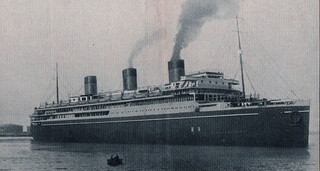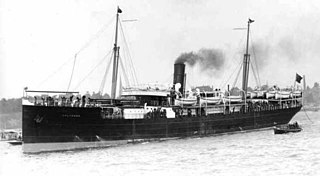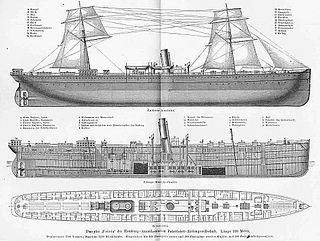
RMS Republic was a steam-powered ocean liner built in 1903 by Harland and Wolff in Belfast, and lost at sea in a collision in 1909 while sailing for the White Star Line. The ship was equipped with a new Marconi wireless telegraphy transmitter, and issued a CQD distress call, resulting in the saving of around 1,500 lives. Known as the "Millionaires' Ship" because of the number of wealthy Americans who traveled by her, she was described as a "palatial liner" and was the flagship of White Star Line's Boston service. This was the first important marine rescue made possible by radio, and brought worldwide attention to this new technology.

SS Atlantic was a transatlantic ocean liner of the White Star Line that operated between Liverpool, United Kingdom, and New York City, United States. During the ship's 19th voyage, on 1 April 1873, she struck rocks and sank off the coast of Nova Scotia, Canada, killing at least 535 people. It remained the deadliest civilian maritime disaster in the North Atlantic Ocean until the sinking of SS La Bourgogne on 2 July 1898 and the greatest disaster for the White Star Line prior to the loss of Titanic in April 1912.

SS Kronprinz Wilhelm was a German passenger liner built for the Norddeutscher Lloyd, a former shipping company now part of Hapag-Lloyd, by the AG Vulcan shipyard in Stettin, Germany, in 1901. She took her name from Crown Prince Wilhelm, son of the German Emperor Wilhelm II, and was a sister ship of SS Kaiser Wilhelm der Grosse.

SS L'Atlantique was a French ocean liner owned by the Compagnie de Navigation Sud Atlantique, a subsidiary of the Compagnie Générale Transatlantique (CGT). When completed in 1931 she was the largest, swiftest and most luxurious ocean liner on the route between Europe and South America.

SS Republic was an ocean liner built in 1871 by Harland and Wolff for White Star Line. It was intended to be the last of four vessels forming the Oceanic class, before two new ships were commissioned. After a rough maiden voyage from Liverpool to New York City on 1 February 1872, the ship was chosen to be on White Star Line's first voyage on the South Atlantic and Pacific line with four other ships, destined for Chile. In 1874, the construction of modern ships SS Germanic and SS Britannic led to SS Republic's becoming the standby vessel of White Star Line. It occupied this position for 15 years, and attempts were made to modernise it in 1888. When RMS Teutonic and RMS Majestic entered service in the following year, the Republic became surplus to White Star's needs.

SS Valencia was an iron-hulled passenger steamer built for the Red D Line for service between Venezuela and New York City. She was built in 1882 by William Cramp and Sons, one year after the construction of her sister ship Caracas. She was a 1,598-ton vessel, 252 feet (77 m) in length. In 1897, Valencia was deliberately attacked by the Spanish cruiser Reina Mercedes off Guantanamo Bay, Cuba. The next year, she became a coastal passenger liner on the U.S. West Coast and served periodically in the Spanish–American War as a troopship to the Philippines. Valencia was wrecked off Cape Beale, which is near Clo-oose, on the west coast of Vancouver Island, British Columbia, on 22 January 1906. As her sinking killed 100 people, some classify the wreck of Valencia as the worst maritime disaster in the "Graveyard of the Pacific", a famously treacherous area off the southwest coast of Vancouver Island.

USS Refuge (AH-11), was a hospital ship of the United States Navy during World War II. The ship was built in 1921 by the New York Shipbuilding Corp., of Camden, New Jersey, as SS Blue Hen State, but was renamed President Garfield in 1923 and then SS President Madison in 1940 for service with American President Lines. Acquired by the Navy from the War Shipping Administration on 11 April 1942 the ship was commissioned as the transport USS Kenmore until conversion to a hospital ship.

SS Pasteur was a steam turbine ocean liner built for Compagnie de Navigation Sud-Atlantique. She later sailed as Bremen for Norddeutscher Lloyd. In the course of her career, she sailed for 41 years under four names and six countries' flags.

SS La Bretagne was an ocean liner that sailed for the Compagnie Générale Transatlantique (CGT) from her launch in 1886 to 1912, sailing primarily in transatlantic service on the North Atlantic. Sold to Compagnie de Navigation Sud-Atlantique in 1912, she sailed for that company under her original name and, later, as SS Alesia on France–South America routes. The liner was sold for scrapping in the Netherlands in December 1923, but was lost while being towed.

Zaanland was a steam single-screw cargo ship built in 1900 by Russell and Company of Port Glasgow for Zuid Amerika Lijn of Amsterdam with intention of carrying cattle from Argentina and Uruguay to various ports in Europe, including England. The cargo ship operated on South America to Europe route during her entire career. She was requisitioned by the US Navy in March 1918 and sunk after colliding with another vessel on her first trip under Navy flag two months later.

SS Volturno was an ocean liner that caught fire and was eventually scuttled in the North Atlantic in October 1913. She was a Royal Line ship under charter to the Uranium Line at the time of the fire. After the ship issued SOS signals, eleven ships came to her aid and, in heavy seas and gale winds, rescued 521 passengers and crewmen. In total 135 people, most of them women and children in lifeboats launched unsuccessfully prior to the arrival of the rescue ships, died in the incident.

SS La Bourgogne was a French ocean liner, which sank in a collision July 1898, with the loss of 549 lives. At the time this sinking was infamous, because only 13% of the passengers survived, while 48% of the crew did. In 1886 she set a new record for the fastest Atlantic crossing by a postal steamer.
Wahehe was a 4,690 GRT cargo ship which was built in 1922 as Wadigo by Reiherstieg Schiffswerfte und Maschinenfabrik, Hamburg for Woermann Linie AG. She was converted to a refrigerated cargo liner in about 1934.

Magdalena was a 17,547 GRT passenger and refrigerated cargo ocean liner that Harland and Wolff built in Belfast in 1948 for Royal Mail Lines (RML). Launched on 11 May 1948, she was the third-largest ship being built in a UK shipyard at that time.

The SS Silesia was a late 19th-century Hamburg America Line passenger and cargo ship that ran between the European ports of Hamburg, Germany and Le Havre, France to Castle Garden and later Ellis Island, New York transporting European immigrants, primarily Russian, Prussian, Hungarian, German, Austrian, Italian, and Danish individuals and families. Most passengers on this route were manual laborers, including stonecutters, locksmiths, farmers, millers, upholsterers, confectioners, and tailors, though physicians and other professionals also bought passage on her.
SS Aquila was a cargo ship built in Britain in 1940 for Stavros Livanos' Trent Maritime Co Ltd. by William Gray & Company. An identical sister, SS Duke of Athens, was made for Trent at the same time.

SS Oceana was a P&O passenger liner and cargo vessel, launched in 1887 by Harland and Wolff of Belfast and completed in 1888. Originally assigned to carry passengers and mail between London and Australia, she was later assigned to routes between London and British India. On 16 March 1912 the ship collided in the Strait of Dover with the Pisagua, a 2,850 GRT German-registered four-masted steel-hulled barque. As a result Oceana sank off Beachy Head on the East Sussex coast, with the loss of 17 lives.
SS Aguila was a British steam passenger liner. She was built in Dundee in 1917 and was sunk by enemy action in the North Atlantic in 1941. She belonged to Yeoward Line, which carried passengers and fruit between Liverpool, Lisbon, Madeira and the Canary Islands.

The SS City of Chester was a steamship built in 1875 that sank after a collision in a dense fog with RMS Oceanic at the Golden Gate in San Francisco Bay on August 22, 1888. She was owned by the Oregon Railroad Co. and leased by the Pacific Coast Steamship Company.

SS Burdigala was an ocean liner that sailed the Atlantic Ocean from 1898 until World War I. The ship was built as the Kaiser Friedrich in 1898 for Norddeutscher Lloyd (NDL), a German shipping line. Designed to break the speed record for a transatlantic liner and thereby win the Blue Riband, the Kaiser Friedrich never achieved the necessary speeds. After a short career with NDL and an equally short period of service with NDL's main German competitor, the Hamburg-Amerikanische Packetfahrt-Aktien-Gesellschaft, the ship was mothballed for a decade. After being sold to the French shipping line Compagnie de Navigation Sud-Atlantique, it re-entered service as SS Burdigala. In 1916, while en route from Thessaloniki to Toulon, the liner struck a mine laid by the German U-boat U-73 in the Aegean Sea and sank near Kea, Greece.
















